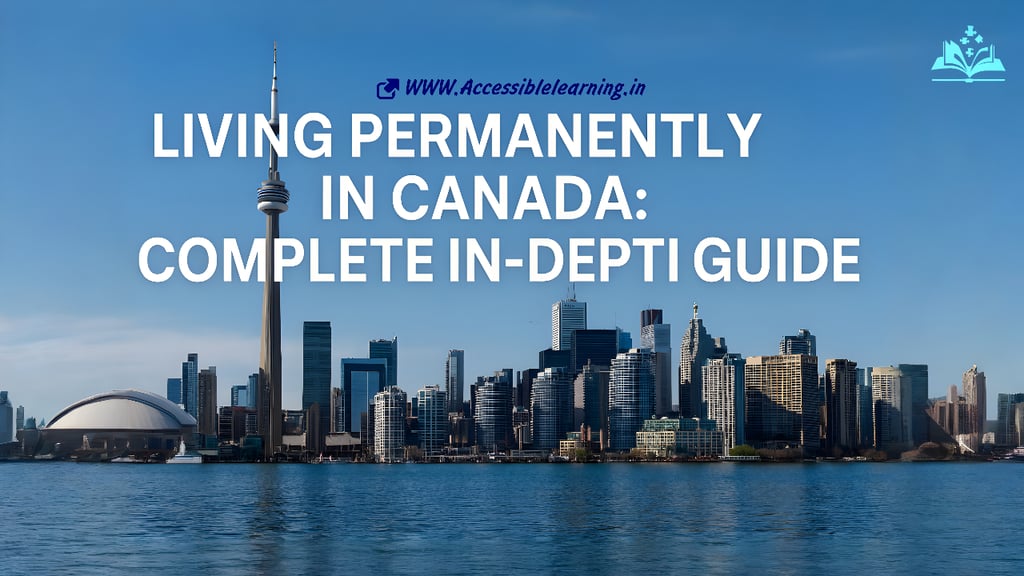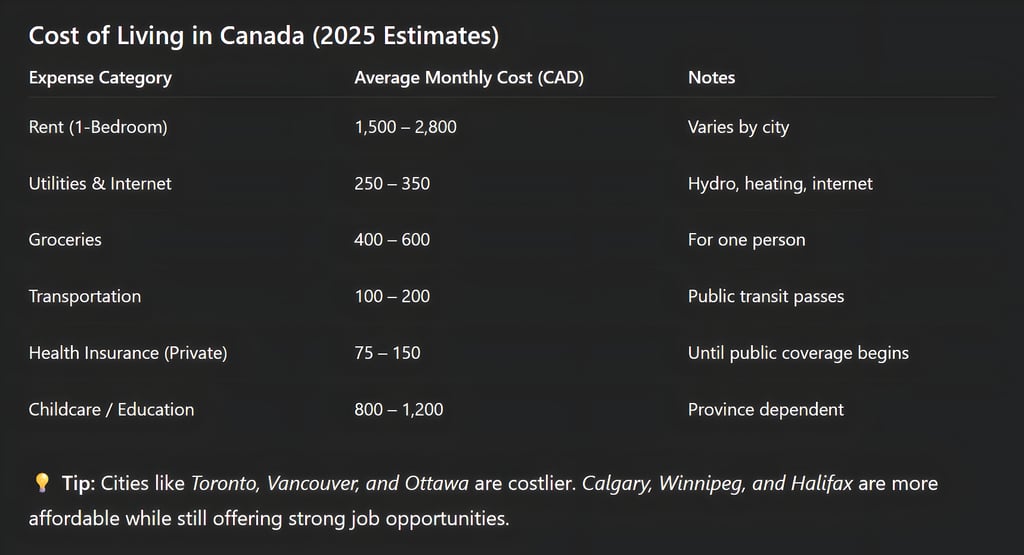
Permanent Residency in Canada Made Simple: Costs, Benefits, and Citizenship Steps
Thinking of living permanently in Canada? Discover the full guide on PR pathways, costs, jobs, healthcare, and how to build a lasting life in Canada.
NEPOTISM/SOCIAL ISSUESAWARE/VIGILANTCANADATRAVEL LIFE
Keshav Jha
10/18/20256 min read


Canada has become a global beacon for individuals seeking stability, safety, and opportunity. From its stunning landscapes to its inclusive immigration policies, the country welcomes people from around the world who aspire to make it their forever home.
However, living permanently in Canada is a structured process—it requires clear eligibility, documentation, financial preparation, and a deep understanding of how permanent residency (PR) and citizenship systems work.
This guide explores every essential aspect—immigration routes, costs, healthcare, employment, housing, taxes, citizenship, and long-term settlement—to help you plan your Canadian future with clarity.
Why Choose Canada for Permanent Living?
Canada consistently ranks among the top countries for quality of life. It offers universal healthcare, excellent education, political stability, and a strong economy. But beyond numbers, it’s Canada’s humanity—tolerance, safety, and community—that attracts millions.
Key Advantages
Safety & Political Stability: Canada ranks among the safest nations globally.
Healthcare Access: Universal coverage under provincial systems.
Economic Growth: Strong job markets in tech, healthcare, education, and skilled trades.
Educational Excellence: World-renowned public universities and affordable schooling.
Multicultural Society: Immigrants represent over 25% of the population.
Permanent Benefits: PRs enjoy most of the same rights as citizens, except voting.
Pathways to Permanent Residency in Canada
Becoming a permanent resident is the most crucial step toward living in Canada indefinitely. Below are the major programs under Immigration, Refugees and Citizenship Canada (IRCC):
Express Entry System
The Express Entry system manages immigration applications for three economic programs:
Applicants create an online profile and receive a Comprehensive Ranking System (CRS) score based on:
Age
Education
Work experience
Language proficiency (IELTS/CELPIP/TEF)
Adaptability factors
Candidates with the highest CRS scores receive an Invitation to Apply (ITA) for permanent residence. Processing times typically range between 6 and 9 months after submission.
Provincial Nominee Programs (PNPs)
Every province (except Quebec and Nunavut) operates its own PNP to meet local labour demands. A nomination through a PNP adds 600 CRS points to your Express Entry score, almost guaranteeing PR selection.
Popular Provincial Streams:
Ontario Immigrant Nominee Program (OINP)—focuses on tech & healthcare.
British Columbia PNP (BCPNP)—ideal for IT professionals and engineers.
Alberta Advantage Immigration Program (AAIP)—prioritizes trades & agriculture.
Saskatchewan Immigrant Nominee Program (SINP)—great for semi-skilled workers.
Nova Scotia Nominee Program (NSNP)—supports healthcare & community roles.
Family Sponsorship Program
Canadian citizens and permanent residents can sponsor eligible family members.
Eligible categories include:
Spouses or common-law partners
Dependent children
Parents and grandparents (via the Family Reunification or Super Visa program)
Sponsors must demonstrate financial capacity and commit to supporting family members for a specific period (usually 3–20 years, depending on relationship type).
Start-Up Visa Program (Entrepreneurs)
Canada encourages innovation and entrepreneurship. The Start-Up Visa Program allows business owners to gain PR by establishing a qualifying business in Canada, backed by a designated organization or investor group.
Minimum investment: CAD 200,000 (via a venture fund)
English/French proficiency required
Must actively manage the business in Canada
Atlantic Immigration Program (AIP)
Designed for the Atlantic provinces—Nova Scotia, New Brunswick, Newfoundland & Labrador, and Prince Edward Island—this program invites workers and graduates who secure job offers from designated employers.
Quebec Immigration Programs
Quebec manages its own skilled worker and investor streams under the Quebec Skilled Worker Program (QSWP) and Quebec Experience Program (PEQ). French proficiency is essential for these programs.
The Permanent Residence (PR) Process: Step-by-Step
Eligibility Assessment: Determine which immigration category suits your background.
Language Test: Take IELTS or CELPIP for English, TEF for French.
Education Credential Assessment (ECA): Verify your foreign degrees through WES, IQAS, or ICES.
Create an Express Entry Profile: Enter the candidate pool.
Receive Invitation to Apply (ITA): Based on your CRS ranking.
Submit PR Application: Include all documents, proof of funds, and medical/police clearance.
Biometrics and Medical Exam: Mandatory for all applicants.
Wait for PR Confirmation (COPR): Processing time varies from 6 to 12 months.


Employment and Economic Opportunities
Canada’s economy thrives on diversity, innovation, and labour mobility. Permanent residents can work freely across all provinces without needing a separate work permit.
In-demand sectors (2025 trends)
Information Technology (AI, cybersecurity, software engineering)
Healthcare (nursing, therapy, medical lab techs)
Construction & Skilled Trades
Green Energy & Environment
Finance, Accounting & Data Analysis
Education & Public Administration
Average full-time salary: CAD 55,000–85,000 annually (depending on skill and location).
Healthcare System and Benefits
Canada’s universal healthcare is administered by provinces, ensuring equal access to medical services for all residents.
Key Points
PR holders qualify for public health coverage.
Each province issues its own Health Card.
Waiting periods (0–3 months) may apply upon arrival.
Prescription drugs, dental, and vision may require private insurance.
Notably, provinces like Alberta and British Columbia provide extended coverage for children and low-income families.
Education and Childcare
Primary & Secondary Education: Free and mandatory for children up to age 18.
Higher Education: PRs pay domestic tuition, which is significantly lower than international fees.
Scholarships & Grants: Available for PR students through federal and provincial programs.
Daycare Costs: Range between CAD 600 and 1,200 per month, but federal subsidy programs aim to reduce this to CAD 10/day by 2026.
Housing & Settlement
Renting
Average rent (2-bedroom): CAD 2,000–3,000 in major cities.
Security deposit: Usually one month’s rent.
Buying a Home
PRs can buy property without restrictions.
Non-residents face a foreign buyer tax in some provinces.
Mortgage eligibility improves after obtaining PR.
Settlement Services
Government-funded organizations like YMCA, ISSofBC, and COSTI offer free assistance for:
Resume writing & job placement
English/French language classes
Housing support
Community integration
Taxes and Financial Planning
Income Tax: Progressive system (federal + provincial).
Average Tax Rate: 20–30%, depending on income bracket.
GST/HST: 5–15% on goods and services.
Tax Benefits: PRs can access credits like the Canada Child Benefit (CCB) and GST refunds.
Retirement Savings: Contribute to CPP (Canada Pension Plan) and RRSPs (Registered Retirement Savings Plans).
Pathway to Citizenship
Once you hold permanent residence, you can eventually apply for Canadian citizenship.
Eligibility Requirements
Physical Presence: Minimum 1,095 days (3 years) in the past 5 years.
Income Tax Filing: For at least 3 years within that period.
Language Test: English or French proficiency (CLB level 4+).
Citizenship Test & Oath Ceremony: Mandatory for adults aged 18–54.
Upon approval, you’ll receive the Canadian passport, one of the most powerful passports globally.
Challenges and Adaptation
Moving to Canada permanently is exciting, but it comes with real challenges:
Cultural Adjustment: Learn local customs and participate in community events.
Climate Adaptation: Invest in proper winter gear; temperatures can drop below –20°C.
Job Recognition: Regulated professions (law, medicine, engineering) require licensing.
Social Connections: Join local groups, volunteer, or network through LinkedIn and community programs.
Tip: Success in Canada depends as much on mindset and networking as it does on paperwork.
Living permanently in Canada is a life-changing journey filled with opportunity, security, and growth. The country offers an unparalleled balance of professional stability, family welfare, and social inclusion.
From choosing the right immigration path to settling comfortably, the key lies in preparation—understanding eligibility, organizing finances, and connecting with the local community.
Canada doesn’t just offer a place to live; it offers a place to belong, thrive, and build a future that generations can cherish.

FAQs
Q: What is the easiest way to get permanent residency in Canada?
The easiest and most popular route is the Express Entry system, designed for skilled workers. Candidates with high Comprehensive Ranking System (CRS) scores, strong language proficiency, and recognized education credentials often receive quick Invitations to Apply (ITA) for permanent residency.
Q: How long does it take to get PR in Canada?
Processing times vary depending on the immigration pathway. On average:
Express Entry: 6–9 months after receiving an ITA.
Provincial Nominee Program (PNP): 9–15 months.
Family Sponsorship: 12–24 months.
Timelines may change based on document completeness and program demand.
Q: How much money is required to move to Canada permanently?
The required amount depends on family size and the selected program.
For Express Entry (2025 estimates):
Single applicant: CAD 14,700
Family of 4: CAD 27,500
These funds must be available as proof of settlement and cannot be borrowed.
Q: Can permanent residents access free healthcare in Canada?
Yes, permanent residents are eligible for Canada’s public healthcare system. However, coverage begins after registering for a provincial health card, and a short waiting period (0–3 months) may apply depending on the province.
Q: Can I include my family in my permanent residency application?
Yes, most immigration programs allow you to include your spouse or partner, dependent children, and, in some cases, adopted children. All family members must undergo medical and background checks before approval.
Q: What is the difference between PR and Canadian citizenship?
Permanent residents can live, work, and study anywhere in Canada but cannot vote or hold a Canadian passport. After fulfilling physical presence and tax requirements (usually 3 years within 5), PR holders can apply for citizenship, gaining full rights and privileges.
Q: Can I lose my permanent residency status in Canada?
Yes, PR can be lost if you:
Stay outside Canada for more than 730 days in 5 years,
Commit a serious crime, or
Misrepresent information during the application process.
Maintaining residency days and good conduct preserves your PR status easily.
Q: Is a job offer mandatory for PR in Canada?
No, a job offer is not mandatory under Express Entry or certain PNPs, but it can significantly boost your CRS score. Some provincial streams, however, require a valid job offer from an eligible Canadian employer.
Q: Can I study in Canada after getting PR?
Yes, as a permanent resident, you enjoy domestic tuition rates, which are 2–3 times lower than international student fees. You can also apply for government scholarships, student loans, and grants.
Q: How long after PR can I apply for Canadian citizenship?
You can apply for citizenship after living at least 1,095 days (3 years) in Canada within the past 5 years, provided you’ve filed taxes for those years and met language and knowledge requirements.
Subscribe to our newsletter
All © Copyright reserved by Accessible-Learning
| Terms & Conditions
Knowledge is power. Learn with Us. 📚


